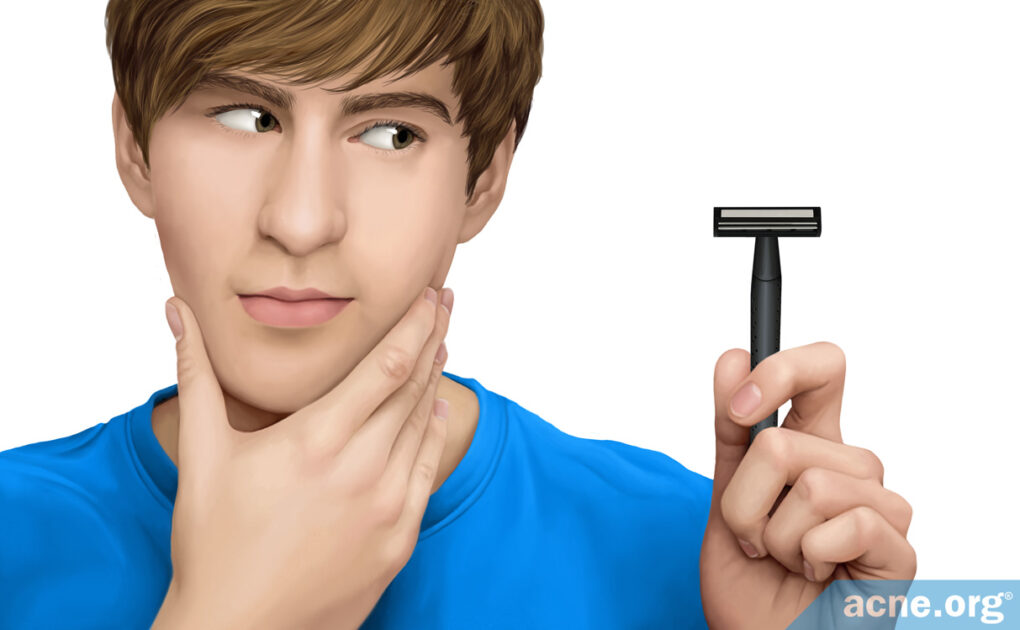Two-blade Cartridge Razors Are the Best Choice for Most People

The Essential Info
There is a proven link between physical irritation and acne, so finding a razor that is suitable for acne-prone skin means choosing one that produces the least irritation.
Currently, four major types of razors exist on the market, and cartridge razors easily win our recommendation.
- Straight Razors: Although good on irritation-prone skin, the risks of getting nicked or cut outweigh the benefits.
- Safety Razors: Like straight razors, safety razors are good on irritation-prone skin, but are also likely to cause nicks.
- Cartridge Razors: Low-irritation and not as apt to cause nicks – choose a 2-blade option like Gillette TracII or Gillette Sensor Excel*.
- Disposable Razors: Ok in a pinch, but not ideal – if going with a disposable, choose a 2-blade variety like BIC® Sensitive™ or Gillette® Sensor2®*.
Once you have the right razor, follow these instructions for the least irritating shave.
Note: Don’t use electric razors. Electric razors cause irritation, especially on the neck, and should be avoided.
* Acne.org is not associated with Gillette or Bic in any way

The Science
When you’re choosing the best razor for acne-prone skin, it all comes down to irritation. Irritation from shaving is so common that it has its own nickname: razor burn. Physical irritation of the skin is well-known to worsen acne, so the goal is to achieve a close shave while doing your best to avoid irritating the skin.
If you’re curious to find out why shaving without irritating the skin is so tricky, feel free to expand the section below. Otherwise, read on as we explore the best razors for acne-prone skin.
Expand to learn why shaving causes irritation

According to a 2016 article in the International Journal of Cosmetic Science, shaving beard hair is challenging because:
- Beard hair grows fast–up to half a millimeter each day–so you need to shave frequently.
- Beard hair varies greatly in thickness, stiffness, and density (how close together the hairs are). The thicker, stiffer, and denser your beard hair, the more pressure you need to apply and the more strokes you need while shaving to get a clean shave.
At the same time, the skin of the chin, cheeks, and neck in men can be especially unforgiving for several reasons:
- The skin around beard hair contains a lot of nerve endings, making the skin in this area sensitive to irritation.
- The skin around beard hair contains many immune cells, which can trigger inflammation when this area is irritated. Inflammation is an important player in the development of acne.
- The skin around beard hair has a high concentration of blood vessels, making the skin quick to bleed when cut.
- Male skin tends to heal more slowly than female skin.
- Male skin is more prone to skin darkening (hyperpigmentation) than female skin, so any kind of cuts or lesions may leave behind dark spots that linger.
For all these reasons, it is important to choose a razor that minimizes skin irritation while shaving.1
The 5 options for shaving on the market are:
- Straight razors
- Safety razors
- Cartridge razors
- Disposable razors
- Electric razors
Let’s have a look at the pros, cons, and cost of each.
Spoiler Alert: Cartridge razors with 2 blades, like the Gillette Trac II or Gillette Sensor Excel are the best for acne-prone skin and are affordable.
1. Straight Razors
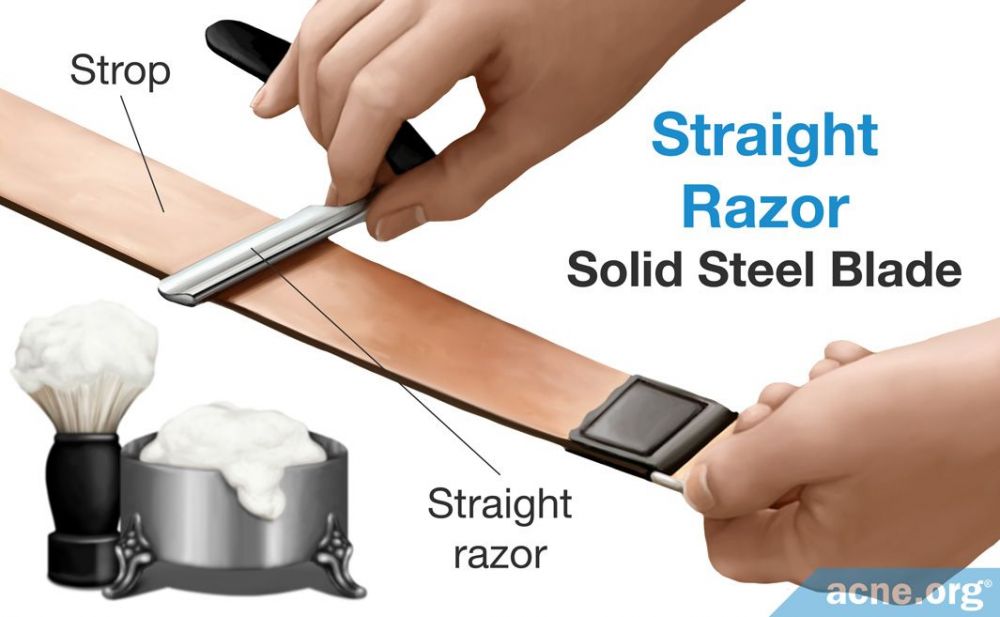
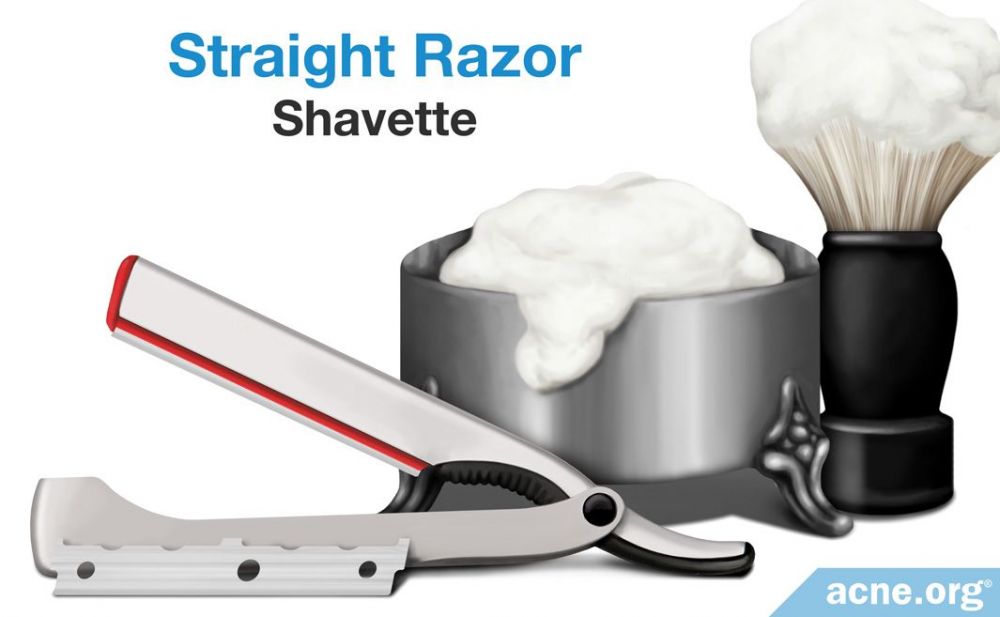
Pros: Cause little irritation.
Cons: Frequent nicks, require more time than other shaving methods.
Cost: Initial investment $140-230; $0 thereafter (shaving cream not included).
Our take: Although good on irritation-prone skin, the risks of getting cut outweigh the benefits.
What are straight razors?
Men have used straight razors for centuries. Straight razors are the “grandfathers” of the razors that we see on the market today. They are of two types.
- A handle and a permanent single piece of metal attached to it that you sharpen against a strop (a thick leather strap used to sharpen the blade).
- A handle with replaceable blades, also known as shavettes, which you do not need to sharpen. Shavettes are the type of straight razor most commonly used in the barbershops, as barbers must swap blades after each customer for sanitary reasons.
Pros:
Cause little irritation: Once you have mastered the craft, you can enjoy the nice, close shave that straight razors provide. Because the blade comes closely in contact with the skin and thus cuts the hair very short, it leaves no stubble. Moreover, a straight razor is one of the preferred options for shaving if you suffer from irritation and/or razor bumps.
- Irritation: Just one sharp blade gliding gently along the skin causes little irritation in most people. Exactly why this is remains a mystery. One of the reasons could be that single-blade razors do not irritate hair follicles as much as multiple-blade razors.
- Razor bumps: Razor bumps, also called ingrown hairs, occur when a hair is shaved and the short shaved hair pierces the skin, causing the skin to respond with inflammation. Most frequently, razor bumps occur in people who shave using razors with three or more blades, where the first blade will raise a hair slightly, and the other blades will then cut the hair. After the hair is cut, it can retract under the surface of the skin. Because the hair is now underneath the skin’s surface, it can regrow at a wrong angle, into the skin, instead of growing out of the skin. Straight razors comprise just one blade that does not cause hair to retract, so people who shave with straight razors are much less likely to suffer from razor bumps.
Keep in mind, though, that once razor bumps have developed on the skin, shaving with straight razors should be avoided because the sharp blade can cut the raised, inflamed lesions. Ideally, you should switch to a beard trimmer or stop shaving entirely until the razor bumps resolve. In addition, if you have active, raised pimples, it may be best to steer clear of straight razors.
Cons:
Dangerous–many nicks: Straight razors are by far the most dangerous shaving option in the sense that you are likely to nick yourself on numerous occasions before you learn how to use one properly. Straight razors feature a handle and a sharpened piece of metal that will easily nick the skin if you are even slightly careless while moving it across the skin. It takes time and practice until you are comfortable with the razor, know exactly how much pressure to apply, and become accustomed to holding the razor at just the right angle, which according to most experts is around 30°.2 “If you hold the razor too flat it will tear the stubble,” says John Rivera, a master barber. “And if held too steep, it will cut the skin.”3
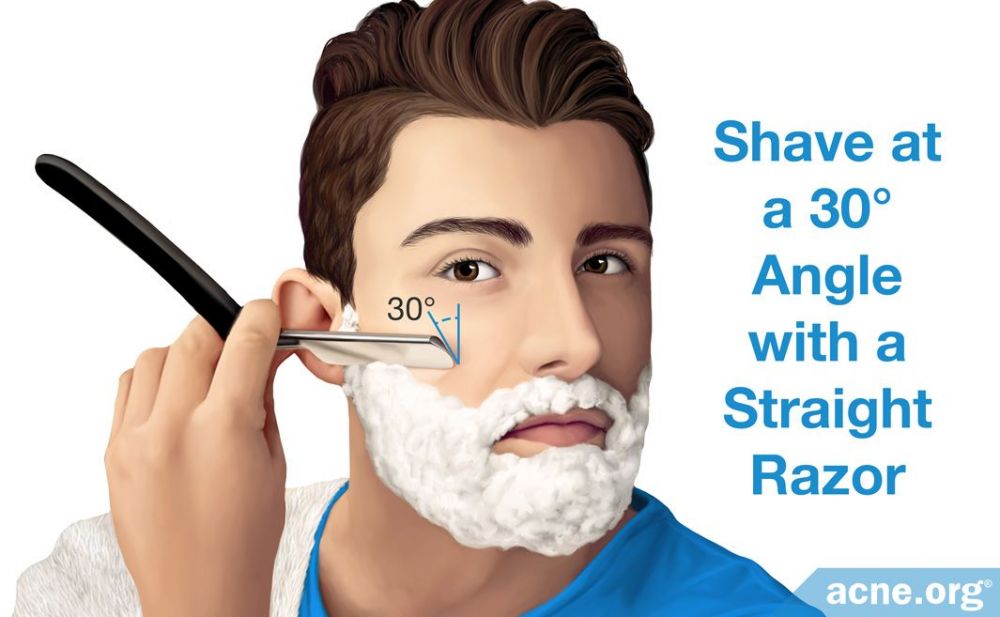
Requires more time than other shaving methods: Because it is easy to cut the skin with a straight razor, shaving with it requires that you be meticulous and focused from the first pass to the last. Losing focus may result in a careless move, and careless moves with a straight razor are fraught with nicks. Therefore, it is not recommended to shave with a straight razor when in a rush. For beginners, a shaving session with a straight razor usually takes between 30 and 45 minutes, and sometimes up to an hour. With practice, you will likely be able to achieve a shave in under half an hour, but that may still be impractical. For that reason, straight razors are the least preferred choice if you need a quick shave.
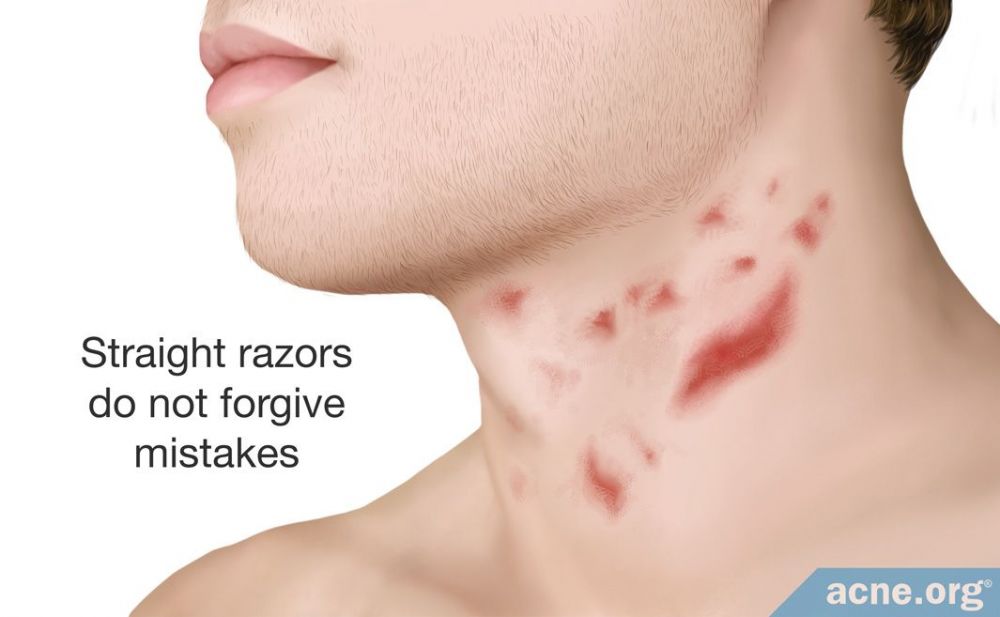
Cost:
Straight razors are quite pricey, especially the quality ones. Expect to spend around $130-200 on a razor and an additional $10-30 on a strop to sharpen the blade. However, a great thing about straight razors is that they are a one-time investment. You will only need to sharpen the blade with the strop thereon, and all shaving-associated expenses will be limited to the shaving cream. Since shavettes are replaceable, in that case you do not need a strop, but you will need to buy replacement blades. One replacement blade lasts for approximately five shaves and cost about $10-15 per pack of 100 (10 – 15 cents per blade), and that will suffice for about 1.5 years if you shave every day.
2. Safety Razors
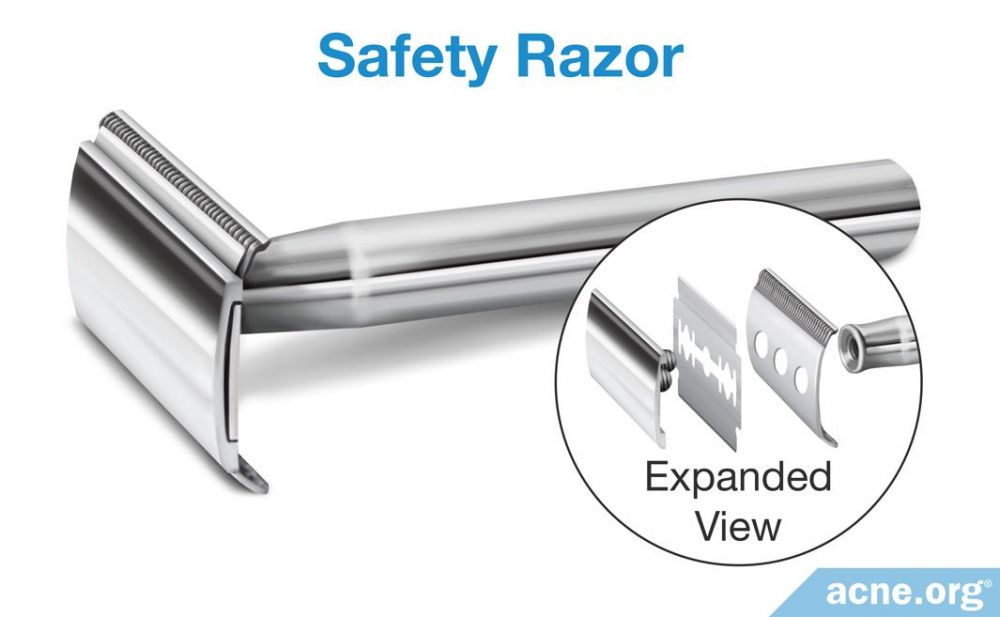
Pros: Cause little irritation.
Cons: Frequent nicks, require more time than other shaving methods.
Cost: Initial investment $30-100, then about $10 per year for blades (shaving cream not included).
Our take: Like straight razors, safety razors are good on irritation-prone skin, but are still likely to cause nicks.
What are safety razors?
Safety razors consist of a handle and a head, where a replaceable double-edge blade is placed.
Safety razors were invented in the late 19th century, but stepped into spotlight when a man named King Camp Gillette, the founder of Gillette, signed a contract to supply US troops during World War I with the company’s innovative double-edge replaceable-blade shaving systems.3 Prior to safety razors, the only option for shaving was a straight razor, which tends to cause many nicks, especially in unskilled hands. The primary purpose of the safety razor was to reduce the level of skill involved and make the shaving experience nick-free. The art of shaving, and injury-free shaving in particular, thus opened up to more people and not only to professional barbers.4
Pros:
Cause little irritation: There are no studies on the level of irritation safety razors cause to the skin, but anecdotal evidence indicates that they are minimally irritating.5 With only one blade gliding across the skin, safety razors cause little irritation, and that means you are unlikely to have acne outbreaks from shaving. It is important to remember, though, that once some pimples and/or razor bumps have already developed, it is better to avoid shaving with a safety razor until the skin clears up. Safety razors are as apt to harm active lesions as straight razors.
Cons:
Many nicks: Although a safety razor supposedly is “safe,” there is still a high risk of injury while using one. Safety razors still require one to be careful in order not to get nicked. Above all, cutting at the right angle, approximately 30°, is crucial, and it takes time to master it.
Still time-consuming: A safety razor is definitely an upgrade from a straight razor in terms of shave duration. However, because shaving with a safety razor still requires the user to be careful, shaving with one is still time-consuming compared to razors invented more recently.
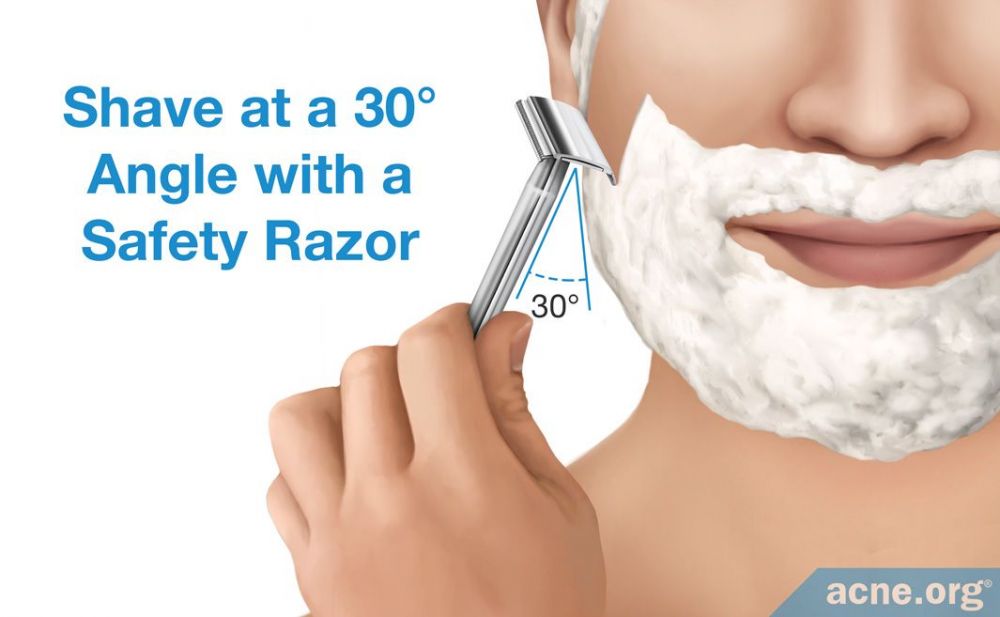
Cost:
A good double-edge safety razor will set you back anywhere between $30 and $100. Blades for safety razors are $10-15 per pack of 100 (10-15 cents per blade) and one blade lasts for approximately five shaves, so a pack of 100 should last for approximately one and a half years if you shave every day.
3. Cartridge Razors
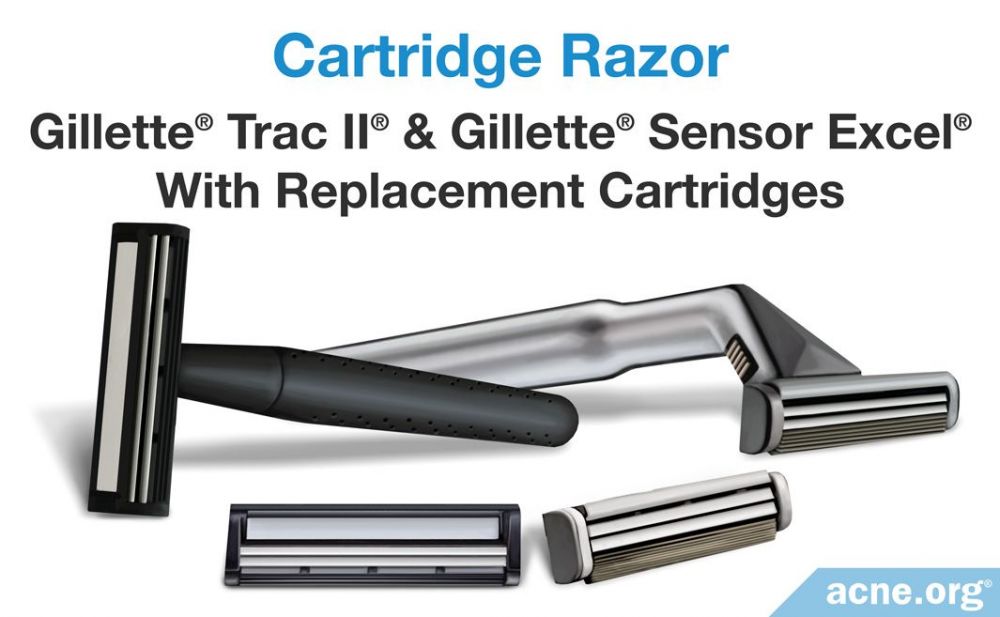
Pros: Minimal irritation when using two-blade cartridge razors, safe, and time-efficient.
Cons: Irritation and razor bumps when using blade cartridge razors with three or more blades.
Cost: Initial investment of $8-15, then $40-100 per year for cartridges.
Our take: In our experience, two-blade cartridge razors are the best for acne-prone skin.
What are cartridge razors?
Cartridge razors are undeniably the most popular shaving systems available today. They consist of a handle and a removable head (cartridge). The cartridge normally contains at least two blades but can hold five or more. Two-blade cartridges tend to produce the least irritation. Most people are satisfied with cartridge razors, while still quite a few people find them irritating, particularly when the cartridges contain more blades.
Pros:
Minimal irritation: Irritation is rarely an issue if you use a two-blade razor. In our experience, cartridge razors like the Gillette® Trac II® or the Gillette® Sensor Excel® provide the benefit of a nice, close shave and are skin-friendly. Also, two blades may not cause hairs to retract and pierce the skin as much as cartridges with three or more blades, and that is why people using them complain less about razor bumps.
Safe and timesaving: The benefit to most cartridge razors is that you can achieve a close shave in just a few minutes because there is a lowered risk of nicks. As a result, you can shave more quickly. Put some shaving cream on wet skin, pass gently a few times, and you are ready to go. Of course, you still need to be careful, but the chances of nicking the skin with a cartridge razor are not nearly as high as with a straight razor or safety razor. In addition, you do not need to worry about the angle of shaving, and you do not need to learn the skill nearly as well as with a straight razor or safety razor. In total, cartridge razors are convenient and safe.
Cons:
Irritation (if cartridges are not replaced in a timely manner): One cartridge is only good for a maximum of one month’s worth of shaves, after which time the blades become dull and should be replaced. In reality, though, many people use them longer than they should, causing dull blades trudging heavily against the skin and irritating it.
Razor bumps: Another problem is that many cartridge razors have three or more blades. In such a razor, the first blade lifts a hair up a bit, and the other blades then cut the hair. After the hair is cut, it can retract under the surface of the skin. Because the hair is now underneath the skin’s surface, it can regrow at a wrong angle, into the skin. This is particularly the case if you pull against the grain, meaning against the growth of the hair. On the face, chin, and neck above the Adam’s apple, hair grows downward, so you should shave downward. In contrast, hair usually grows upward on the neck below the Adam’s apple, so you should shave upward.
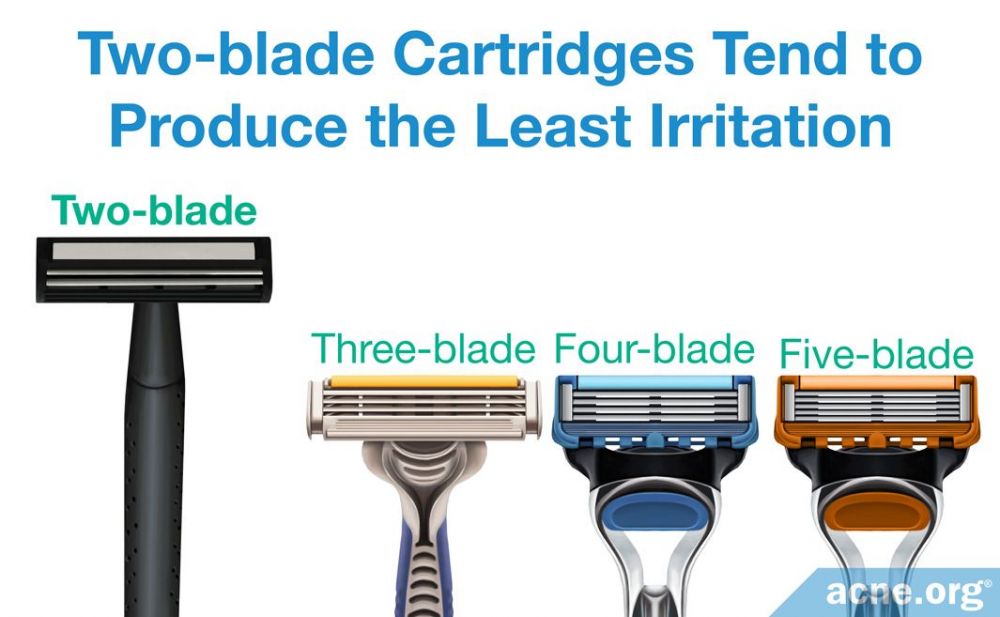
Cost:
As for the associated costs, let’s do the math taking Gillette® Sensor Excel® and Fusion5® as examples.
Gillette® Sensor Excel®: The razor with a preattached cartridge plus one extra cartridge is sold for around $13. The price for a pack of ten replacement cartridges varies greatly from vendor to vendor, with an average of about $25. So, the price per cartridge equates to $25/10, which equals $2.50. One cartridge lasts for about three weeks. There are 52 weeks in a year, so you need at least 17.33 cartridges per year (52/3 = 17.33). That makes the annual cost $2.50*17.33, which equals $43.33 per year after the initial investment of $13.
Gillette® Fusion5®: A handle plus one cartridge can be purchased for approximately $10. A pack of eight cartridges costs $35, on average, equating to $4.37 per cartridge ($35/8 = $4.37). One cartridge usually lasts for about three weeks. As stated, there are 52 weeks in a year, so you need at least 17.33 cartridges per year (54/3 = 17.33). That makes the annual cost $4.37*17.33, which equals $75.75 after the initial investment of $10.
4. Disposable Razors
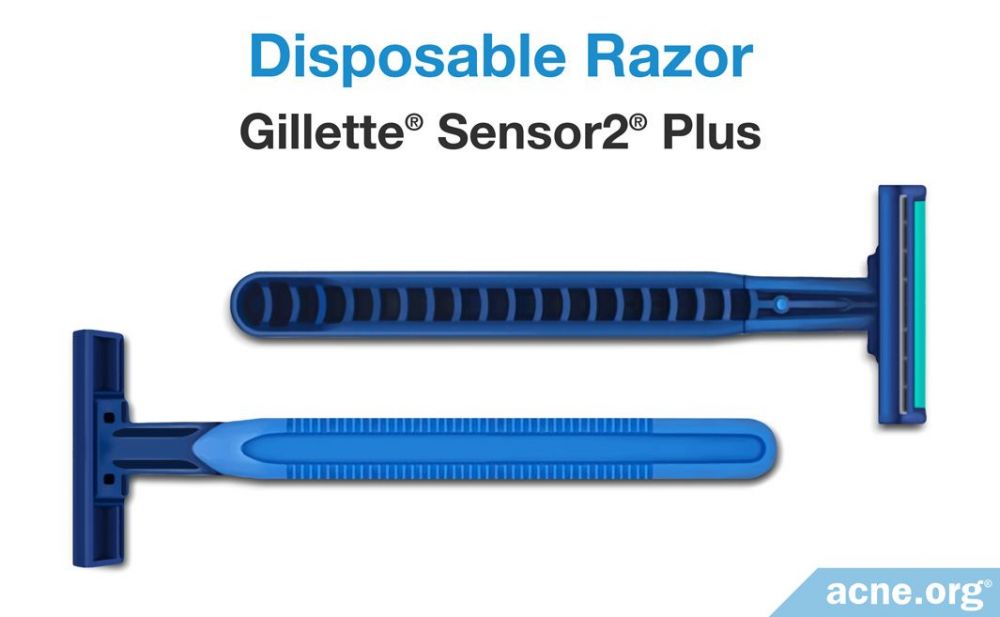
Pros: Safe and time-saving.
Cons: Last only for 2 to 3 shaves.
Cost: $60-120 per year.
Our take: Disposable razors are fine in a pinch, but two-blade cartridge razors are superior.
What are disposable razors?
Disposable razors are plastic razors that you throw away after a few uses. They usually feature 1 or 2 blades and rarely 3 or more. After 2 to 3 shaves, the blades dull, and the entire razor is thrown away. Regarding how much irritation they cause, it is impossible to generalize because there are many cheap, low-quality options that should be avoided. At the same time, there are some options that cause little irritation. For that reason, we will abstain from labeling the disposable razors irritating or non-irritating.
Pros:
Safe and timesaving: Disposable razors are comparable to cartridge razors in terms of safety and the amount of time you need to shave. They can provide a close shave in just a few minutes with little risk of nicking your skin.
Cons:
Last for only 2 to 3 shaves: There is no rule saying how long you should use a disposable razor, but most of them give a comfortable, low-irritation shave for only 2 to 3 shaves. After this point, the blades dull and cause irritation, and since we know irritation may trigger acne,6 they should only be used a few times at most if you have acne-prone skin.
Cost:
Let’s calculate the approximate cost of shaving with two disposable razors: BIC® Sensitive™ and Gillette® Sensor2®.
- BIC® Sensitive™: The price per pack of 12 is on average around $8, so each razor costs around 66 cents ($8/12 = 66 cents). Assuming one razor lasts for three shaves, you will need about 122 razors per year (365/3 ≈ 122). Annual expenses thus amount to $0.66*122, which equals $80.52.
- Gillette® Sensor2®: A pack of 12 costs on average around $10, so each razor costs around 83 cents ($10/12). Annual expenses thus amount to $0.83*$122, which equals $101.26.
5. Electric Razors

Pros: No need for water or shaving cream.
Cons: Cause skin irritation.
Cost: Initial investment of ~$40 up to $100 or more, then around $20 every other year for the shaver head.
Our take: In our experience, electric razors almost always cause irritation, particularly on the neck, so it is better to stick with traditional blade shaving.
What are electric razors?
An electric razor (also known as a dry razor, electric shaver, or simply a shaver) is a razor with an electrically powered rotating or oscillating blade. An electric shaver usually does not require the use of shaving cream, soap, or water. As the electric shaver moves over the face, hairs poke through small holes in the foil, where spinning blades cut the hair. While this may seem like it would be less irritating, most men experience more irritation when using an electric razor. There are 2 main categories of electric razors: foil or rotary-style, and both are irritating.
Pros:
Convenience: The main benefit of electric razors is their convenience. By eliminating the need for wetting and lathering the skin, electric razors simplify shaving on-the-go.
Cons:
Irritation: The biggest disadvantage of using electric razors is irritation, especially for people with acne-prone skin. This may seem counter-intuitive since the blades in an electric razor do not directly contact the skin. However, a recent study found that nearly half of those who used electric razors experienced some form of skin irritation. The neck turned out to be the area most susceptible to irritation from electric shavers.7
Cost:
The initial cost of an electric razor can be on the higher side. An electric razor can cost from $40 to $100 or more, depending on the brand you choose. However, in the long run, electric shavers do turn out to be a good investment. If you take good care of your shaver, you can use it for about 2 years before needing to change the shaver head, which costs around $20. You will also end up saving money by not having to regularly buy shaving cream. Thus, the cost might be more than $100 in the first year, but potentially $0 the following year, and then only around $20 every other year.
References
- Maurer, M., Rietzler, M., Burghardt, R. & Siebenhaar, F. The male beard hair and facial skin – challenges for shaving. Int. J. Cosmet. Sci. 38 Suppl 1, 3-9 (2016). https://www.ncbi.nlm.nih.gov/pubmed/27212465
- Keir, L., Wise, B., Krebs, C. & Keir, L. Medical assisting. 885 (Delmar Learning, 2007).
- Razor. Encyclopedia Britannica (2014). at https://www.britannica.com/technology/razor#ref57580
- Safety razor. Wikipedia (2017). at https://en.wikipedia.org/wiki/Safety_razor#cite_note-4
- Goldstein, B. & Goldstein, A. Pseudofolliculitis barbae. UpToDate (2017). at https://www.uptodate.com/contents/pseudofolliculitis-barbae
- Skin care for acne-prone skin. PubMed Health (2017). at https://www.ncbi.nlm.nih.gov/pubmedhealth/PMH0072392/#i2077.behandlung-6m.shavingwetordry
- Sukakul, T., et al. Facial hair shaving behavior and skin problems of shaved areas of males. The Journal of Dermatology 48, 1409-1413 (2021). https://pubmed.ncbi.nlm.nih.gov/34254359/
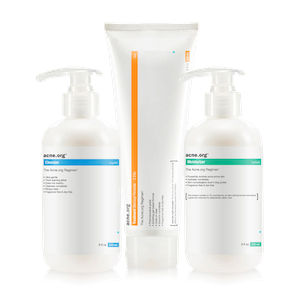 Acne.org Products
Acne.org Products